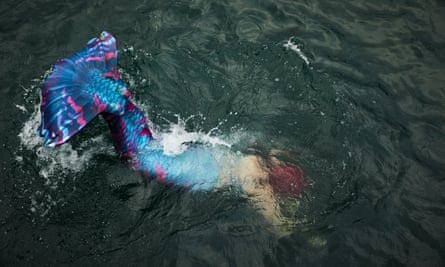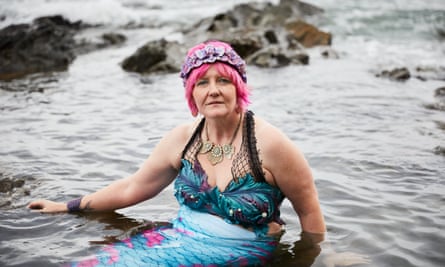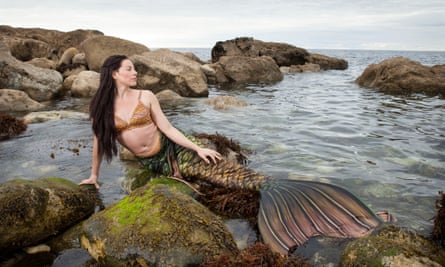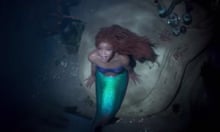A tail arcs up, spraying droplets of seawater over the people standing on the pontoon dock. The children rush forwards, enchanted. A mermaid, who has pulled herself up on to a paddle board, laughs, water streaming from her hair. Her tail colouring mimics the rich greens and browns of the local sea life.
The group on the dock have paid for a Meet a Mermaid session as part of Portland Week on Dorset’s Isle of Portland, an event put on to raise money for the environmental group Clean Jurassic Coast. But everyone in the surrounding marina is equally captivated. The mermaid slaps her tail down. The noise is loud and not human. The echoing fin smacks the water like a diving whale.
On land, the green and brown mermaid is Hannah Cadec – or Mermaid Taurva – who lives on a nearby houseboat. She’s a small woman and walks with a dancer’s bounce. There is, however, a telltale piece of seaweed caught in the ends of her hair. “It gets everywhere,” she says. “I’m always finding bits of it in the shower.”
Mermaiding originated in the US, but Hannah, 32, is one of a growing number of mermaids in the UK. There’s no official count, but people in the community estimate their number at around 600. Grace Page, founder of Hire a Mermaid UK, believes she was one of the first three mermaids in the country.
Grace, like other mermaids, uses a monofin, a large single flipper into which both feet slot. They are also used by free divers and underwater orienteers and provide valuable propulsion. They are expensive, though – silicone tails can cost more than £2,000 – and are often made by hand. Grace references Siki Red, Prisma Tails and the Mermaid Asylum as independent UK tailmakers, but it’s not unusual for mermaids to search globally for the right tail. Hannah’s tail might match the fish and seaweeds of the Dorset coast, but she bought it from a creator in South Africa. Cheaper fabric tails are available, too, and can provide a useful entry point.

Grace started swimming with a tail from 2011 and making paid mermaid appearances from 2013. “There was a burlesque group who had full tails in their act, but that was about it. Now I think there are probably around 90 people doing it professionally,” she says. “But it’s a hobby for many more.”
Grace, who has also represented the UK in the World Mermaid Championship, has 50 professional merfolk on the books of her agency and 1.4m followers on TikTok. Kate Macleod, also known as the Hebridean Mermaid, has created and presented a series of documentaries, Miann na Maighdinn-mara/Mermaid Tales, for the Gaelic language channel BBC Alba. The St Ives Mermaid, Laura Evans, is seeking pledges for a book about her experiences, on the crowdfunding publishing platform Unbound. There are mermaids in tidal pools, harbours and leisure centres and in tanks at the Blackpool Sea Life centre.
Mermaiding’s popularity began with Australian swimmer Annette Kellerman, who starred in the 1911 film Siren of the Sea, where she was the first actor to swim in a tail (she is also credited with the invention of synchronised swimming and being the first high-profile woman to wear a modern one-piece bathing suit).
In 1952, US actor Esther Williams starred in Million Dollar Mermaid, a biography of Kellerman, but the real heart of American mermaiding is in Weeki Wachee in Florida, a freshwater spring that has hosted mermaid shows for 75 years. But, says museum professional Rebecca Schwandt, performers only started swimming in tails in the 1960s. Schwandt’s master’s thesis centred around oral histories of the women performing at Weeki Wachee. “For the mid- 20th-century performers, it was a job you could take in the local area. If you didn’t want to be a teacher or a housewife, then you could be a mermaid,” she says. “But at the same time they all also talk about the magic of being under the water. It was way more than just a job.”
The swelling numbers of UK mermaids belie the relative difficulty. Aside from needing to be a strong swimmer and confident in (and under) the water, you can’t just buy a fancy dress outfit and drop into your nearest pool. To start with, many swimming pools require mermaids to apply for special permission for safety and insurance reasons. Tails, too, must be safe.
A poorly made tail can be hard to get out of and become nothing more than a water-saturated leg bind. If the tail fin is overly buoyant, it will be very difficult for a swimmer to keep their head above the surface. Learning to free dive, to move underwater without air-supply equipment, means learning to manage the body’s response to carbon dioxide buildup and not gasping for breath when there is no oxygen available. Sea-swimming mermaids must adjust to the cold and monitor wave heights, tidal patterns and, increasingly, sewage outflow.
But these are practicalities. Most mermaids are entranced by the magic of it – by the freedom, the strange beauty, by becoming something other, even temporarily.
“Sincerely, it’s changed my life,” says Tasha Fairey, 34, who has been swimming as a mermaid in her native Cornwall for a year. She had been working in a care home for just two months before Covid hit. “All of a sudden the residents were dying. It was really hard because you form a bond with people when you’re looking after them,” she says. “You had to get on with it because you knew no one was going to come and save you.” Eventually, stress and grief led to depression and anxiety, and Tasha quit her job.

She had always enjoyed swimming, learning “before I could really walk” in the sea near her father’s house in Mullion on the Lizard peninsula. “It’s otherworldly, being under the water,” she says. She would sometimes see mermaids off the coast or at events. “I thought they were wonderful,” she says. “But I’d closed myself off. I thought I was too old.”
Some months later, Tasha purchased a fabric tail and posted a picture of herself on Instagram. She received a message from another Cornish mermaid inviting her to an event in Porthleven to swim with a local pod (a social group of mermaids is called a pod, as with dolphins, whales and seals). “It was nerve-racking,” Tasha says, describing walking up to the harbour with her tail in her hands.
“I’ve never been a person with a lot of friends. I can be quiet and reserved. I didn’t expect a community, I didn’t expect to be welcomed in, but that’s what I found. I’m right in the thick of things now and I am so glad.”
The Porthleven Mermaid Day is organised by Suzie Inman, 43, a copywriter, PR and marketing professional. For Suzie, the catalyst was her 40th birthday. She had saved for a year to buy a tail and says, “I wanted to mark the event and do something for me.” She has lived in Cornwall for 13 years, but grew up in Lytham, Lancashire, where her grandfather was a fisherman. “We were taught to respect the sea, and we didn’t swim in it much, because there are some deep tidal patterns round there,” she says. She did, however, swim in pools. As a little girl she was always the one to dive and retrieve lost jewellery from the deep end. As a teenager she swam competitively for Lancashire.
The first time she wore her tail she sat on the edge of Porthleven harbour “feeling a bit like a slug. I dropped over the side, briefly went under and then started swimming.”
Hannah Cadec hasn’t always been a mermaid either. For over a decade she performed in West End shows, appearing in Rocky Horror Show, Phantom of the Opera, South Pacific and more. “I’ve done Wicked three times, including in German,” she says. It was during a touring production of Wicked that Hannah started to experience issues with her vocal cords. She was the show’s swing, a musical theatre term for a performer who can take on any role in the production at short notice. Her voice vanished.
“I couldn’t even speak,” she says. Even now, nearly three years later, two mermaid performances followed by an interview have caused her to talk with a tight huskiness.

As the pandemic lockdowns started, Hannah was also without the accommodation a touring production would have provided. She had taken a free-diving course, with a view to working as a mermaid, and became friends with the assistant instructor. He needed someone to look after his houseboat. Hannah landed in Dorset and, surrounded by water, started to swim.
“I’m the opposite of the Little Mermaid,” she says. “She lost her voice to walk on the land. I lost my voice and headed into the sea.”
The Little Mermaid, both the bleak Hans Christian Andersen original and the far sunnier Disney version, crops up in references time and again. Ashleigh More, 30, describes the Disney film as a childhood obsession. “My mum even put an ad in the local paper asking if anyone had a VHS copy. Like, ‘Please send it because my daughter will not stop singing these songs.’” Ashleigh sees the story as a reminder about giving up your voice and not letting others speak for you. She still loves the film and plans to attend an upcoming Comic-Con in Edinburgh in order to meet Jodi Benson, who provided the voice for the central character, Ariel. “I have to tell her what she’s meant to me,” she says.
Ashleigh is the Moray Firth Mermaid. She lives in Edinburgh, working as an actor and a tour guide, but frequently returns to her home town, Hopeman, and the sea where she grew up with. She says her six-year-old self would have been amazed at what she has managed to become, but mermaiding means more to her than fulfilling a childhood fantasy.
“There’s a strong feminine energy to it and there’s also the connection with folklore and history,” she says. Like Suzie Inman, Ashleigh’s grandfather was also a fisherman, as were several of her other relatives. “Saltwater runs in my blood,” she says. “I call myself the Moray Firth Mermaid because it’s where my ancestors have always been. There’s a sense of belonging with the sea. It’s part of our culture and our heritage as Highlanders.”
In the west of Scotland, Kate Macleod is captured from above, moving through a northern sea of chill turquoise, her tail rippling out behind her. The aerial shot is from the introduction to Miann na Maighdinn-mara and the point where the magic of the landscape makes you believe that the swimmer below could – possibly – be magical, too.
Kate and the production team at MacTV have made two series of the show, which have Kate exploring the history and nature of her local area. She was, however, already swimming with a tail off the coast of Lewis before the series was even thought of, causing local fishermen to double take as she went past.
“I thought, ‘Why not?’” Kate says. “I was halfway there already. The water has always been a second home to me.”

She’s hugely enthusiastic about her monofin. “They’re extremely powerful,” she says. “But at the same time you can glide through the water without disturbing the rest of the environment at all. The experience is completely different; you’re a part of things rather than just an onlooker. The tail is the ultimate connection to the sea.” She describes her experiences swimming with basking sharks, creatures that were over five times her size, and diving off the coast of St Kilda and finding a cave with what looked like a set of underwater manmade steps descending into the depths.
Grace Page, who also runs the Miss Mermaid UK pageant, says: “To be a mermaid in the UK you have to really want to do it. You have to have the passion to keep at it, even if you can’t train in your local pool. You have to love it enough to swim in very cold water.”
The payoff to this resilience is creating magic. There’s magic for the individual, as a skilled mermaid has more freedom underwater than most humans do. There’s also the joy of bringing magic to others, of a small child with wide eyes, or being spotted “in the wild” while sea swimming.
“We have always created creatures and monsters in our minds,” says Marina Warner, a historian and mythographer. “Mermaids are an inviting and seductive example of that. It’s about seeing ourselves as not entirely human… there is a deep yearning in our mechanised, technologised world to become something organic, of the sea as well as of the land. It’s a pleasurable place to be, suspended between belief and disbelief.”
“Sometimes,” says Tasha Fairey in Cornwall, “when we are all swimming together in a pod, even though I’m one of them, too, I look around and think to myself, ‘Bloody hell, I’m surrounded by mermaids.’ And it never stops being incredible.”



